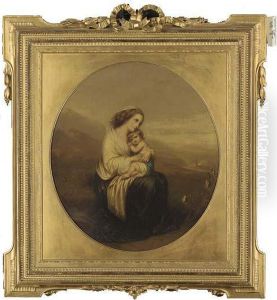Fanny Geefs Paintings
Fanny Geefs, born Stephanie-Françoise (Fanny) Corr, was a Belgian painter known for her portrait works and historical scenes. Born on February 27, 1807, in Brussels, she was part of a family deeply involved in the arts. Her brothers, Charles and Joseph Corr, were both painters, and through their connections, she was introduced to the art world at a young age.
Fanny married the Belgian sculptor Guillaume Geefs in 1836, and thus became part of the Geefs artistic dynasty, which included her husband's brothers, the sculptors Joseph and Jean Geefs. This family environment further nurtured her artistic development, and she became well-known in her own right. Her marriage to Guillaume connected her to a network of influential artists and patrons, which was crucial for her career.
Throughout her life, Fanny Geefs was active in the Belgian art scene, exhibiting her work at various salons and exhibitions. Her paintings often depicted figures from history and literature, executed with a fine attention to detail and a clear narrative style. She was particularly adept at portraiture, capturing the likeness and character of her subjects with sensitivity and skill.
One of her most notable works is the portrait of Henriette Mayer van den Bergh, a prominent philanthropist and art collector of the time. This portrait exemplifies Geefs' talent for portraying her subjects with grace and dignity, a quality that made her portraits sought after by the Belgian elite.
Despite her achievements, Fanny Geefs, like many women artists of her era, did not receive the same level of recognition as her male counterparts. However, her contributions to Belgian art have been reassessed and celebrated in more recent times, as part of a broader effort to acknowledge the work of women artists throughout history.
Fanny Geefs' life was one of creativity and artistic contribution, and she remained active until her later years. She passed away on January 23, 1883, in Schaerbeek. Her legacy lives on through her paintings, which continue to be appreciated for their beauty, craftsmanship, and portrayal of 19th-century Belgian society.








